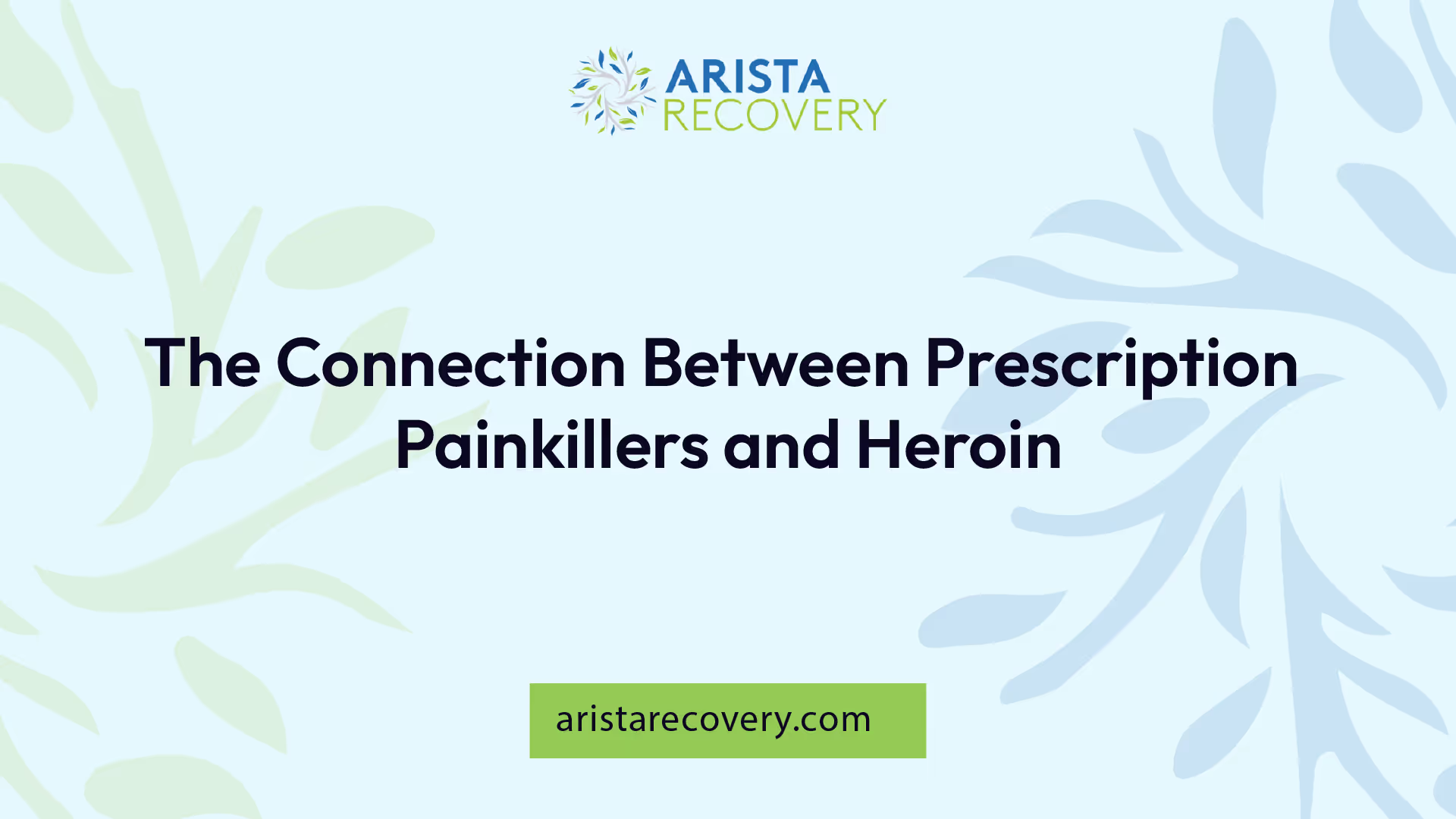The Connection Between Prescription Painkillers and Heroin

The Link Between Prescription Painkillers and Heroin
Understanding the connection between prescription painkillers and heroin is crucial in addressing opioid addiction. The misuse of prescription opioids and the subsequent transition to heroin use have become significant issues in the United States.

Rise in Prescription Opioid Misuse
The dramatic increase in the prescription of opioid medications such as oxycodone and hydrocodone has led to widespread misuse of both prescription and non-prescription opioids. According to data from the HHS, this increase correlates with the escalating opioid crisis in the country. In 2012 alone, healthcare providers wrote 259 million prescriptions for opioid pain medications, which was enough for every American adult to have a bottle of pills.
YearPrescriptions Written (Millions)20021742012259
Transition from Prescription Painkillers to Heroin
The transition from prescription painkillers to heroin is a concerning trend. Studies have shown that the incidence of heroin initiation between 2002 and 2012 was 19 times higher among individuals who reported prior nonmedical use of pain relievers compared to those who did not (0.39% vs. 0.02%) [2].
In the 2000s, approximately 75% of individuals entering treatment for heroin addiction reported that their first opioid was a prescription drug. Furthermore, nearly 80% of heroin users in a national study disclosed that they used prescription opioids before transitioning to heroin [2]. This shift highlights the critical link between the misuse of prescription opioids and the rise in heroin use, necessitating targeted interventions for those at risk.
To learn more about how many users have progressed from prescription painkillers to heroin, visit our article on how heroin addiction starts by using prescription painkillers.
Impact on Treatment Seekers
Understanding the impact of prescription painkillers on those seeking treatment for addiction reveals important trends and correlations. Many individuals struggling with heroin use have a history of prescription opioid misuse, highlighting a complex relationship between these two substances.
Shift from Historical Trends
Historically, the majority of people entering treatment for heroin addiction had begun their journey with heroin itself. In the 1960s, over 80% of those seeking help reported starting with heroin. However, this trend has dramatically shifted in recent years. By the 2000s, approximately 75% of individuals in treatment for heroin addiction stated their first opioid was a prescription drug (National Institute on Drug Abuse). This shift points to a critical change in patterns of substance use and addiction.
YearPercentage of Treatment Seekers Starting with Prescription Drugs1960s20%2000s75%
Relationship Between Prescription Opioids and Heroin Use
The connection between prescription painkillers and heroin is evident in the initiation patterns of drug use. Pooling data from 2002 to 2012, it was found that individuals who had previously used nonmedical pain relievers were 19 times more likely to initiate heroin use compared to those who did not have a history of opioid misuse (0.39% vs. 0.02%) (National Institute on Drug Abuse). This suggests that nonmedical usage of prescription painkillers serves as a significant risk factor for transitioning to heroin.
A 2008-2009 study focused on young, urban injection drug users revealed that 86% had used opioid pain relievers nonmedically prior to trying heroin. These individuals typically sourced their opioids from family, friends, or personal prescriptions (National Institute on Drug Abuse). Further emphasizing this pattern, nearly 80% of heroin users reported using prescription opioids before switching to heroin, illustrating the direct relationship between the two types of drug use.
The evolving landscape of addiction underscores the need for tailored treatment approaches for those affected by this dual dependency, as detailed in the article about how a heroin addict started by prescription painkillers. Understanding these connections is critical for professionals working to combat the opioid crisis and develop effective cures for heroin addiction.
Government Initiatives to Combat Opioid Crisis
The government has implemented various initiatives to address the opioid crisis, particularly the link between prescription painkillers and heroin. These efforts aim to curtail the misuse of prescription opioids and prevent the transition to illicit drugs like heroin.
The HEAL Initiative
Launched in 2015, the Helping End Addiction Long-term (HEAL) Initiative is a federal effort focused on reducing overdose cases and preventing opioid use disorders. This initiative, spearheaded by the National Institutes of Health, is designed to support research that targets the opioid epidemic and offers holistic solutions for addiction treatment [3].
Objectives of the HEAL Initiative
ObjectiveDescriptionResearch ExpansionFund research to improve pain management and reduce the need for prescription opioids.Understanding AddictionInvestigate the biological mechanisms of addiction to inform better treatment methods.Training and EducationEnhance training programs for healthcare providers on addiction prevention and treatment.Public AwarenessIncrease public awareness regarding the risks associated with opioid use and the potential transition to heroin.
CDC Guidelines and Initiatives
The Centers for Disease Control and Prevention (CDC) has been proactive in establishing guidelines regarding opioid prescriptions. In 2016, the CDC issued the CDC Guideline for Prescribing Opioids for Chronic Pain. This guideline emphasizes the need for careful consideration when prescribing opioids to minimize the risks of misuse and addiction. Following this, in 2019, the CDC provided additional advisement to address inconsistent policies and practices surrounding the guideline recommendations [3].
Key Elements of CDC Guidelines
Guideline ElementDescriptionLimit PrescriptionsEnsure short-term prescriptions are prioritized over long-term opioid therapy for chronic pain.Risk AssessmentConduct thorough assessments of patients for potential risk factors related to opioid use.Patient MonitoringRegularly monitor patients who are prescribed opioids to identify misuse or escalation of dosage.Encouragement of AlternativesPromote non-opioid treatment methods for managing chronic pain.
These government initiatives aim to mitigate the rising trend of addiction stemming from prescription painkillers and to reduce the prevalence of heroin use among those affected by opioid use disorders. By addressing the prescription practices and providing comprehensive treatment guidelines, they seek to create sustainable solutions to the opioid crisis. For more insights on the relationship between prescription painkillers and heroin, consider exploring the topic of how many heroin addicts started by prescription painkillers.
Strategies for Prevention and Control
Addressing the interplay between prescription painkillers and heroin requires effective strategies for prevention and control. Two critical components in this approach are Prescription Drug Monitoring Programs (PDMPs) and the implementation of Abuse-Deterrent Formulations (ADFs).
Prescription Drug Monitoring Programs
Prescription Drug Monitoring Programs (PDMPs) are state-run electronic databases that track prescriptions for controlled substances. These programs have been associated with lower rates of opioid prescribing and overdose in some states [3]. By monitoring prescriptions, healthcare providers can identify potential misuse and take necessary actions to intervene before escalation to more dangerous substances like heroin.
Despite their effectiveness, several issues regarding PDMPs remain unresolved. These issues include:
ChallengesDescriptionBest PracticesNeed for standardized guidelines across states.Ease of UseVariability in user-friendly interfaces and accessibility.InteroperabilityIntegration between state systems for comprehensive data.
Importance of Abuse-Deterrent Formulations
Abuse-Deterrent Formulations (ADFs) are specifically designed to reduce the potential for misuse of opioid medications. These formulations make it more difficult to manipulate the pills for misuse. ADFs represent an important area of development in opioid medications; however, the evidence supporting their effectiveness in reducing misuse still requires further investigation [4].
The potential benefits of ADFs can be summarized in the table below:
BenefitDescriptionReduced Risk of MisuseDifficult to alter for misuse, thereby lowering addiction potential.Safer AlternativeProvides a maintained level of pain control without increasing abuse risk.Encourages Responsible UsePromotes patient adherence to prescribed usage.
Employing these strategies can help mitigate the risks associated with prescription painkillers and their connection to heroin use. Awareness and education around the impacts of prescription drugs on addiction are crucial in supporting individuals facing these challenges. For further reading on how addiction often begins, explore our article on how a heroin addict started by prescription painkillers.
Addressing the Opioid Epidemic
Transition from Prescription Opioids to OUD
The transition from prescription opioid use to opioid use disorder (OUD) is a critical component of the ongoing opioid epidemic. At least 2 million people have an opioid use disorder involving prescription opioids, with nearly 600,000 associated with heroin. The intertwining nature of prescription and nonprescription opioids highlights the need for strategies that focus on reducing both OUD and related harms.
Implementing effective policies and clinical practices is essential to reshape prescribing practices and minimize new cases of prescription opioid-induced OUD. Strategies to address this issue include:
StrategyDescriptionRestricting SupplyRegulating which products can be approved for use.Influencing Prescribing PracticesEducating healthcare providers and issuing prescribing guidelines.Reducing DemandEducating patients about the risks of opioids and increasing access to OUD treatment.Reducing HarmProviding naloxone and establishing needle exchange programs.
These approaches aim to lower mortality rates from opioid overdose and mitigate various opioid-related harms.
Reducing Opioid Demand and Harm
Reducing the demand for opioids and their associated harms requires a multifaceted approach. Educating patients about the risks linked to opioid medications is vital. Studies illustrate that informed patients are less likely to misuse opioids and may seek alternative pain management options.
The demand-side strategies should include:
On the supply side, effective regulation of opioid prescriptions will help ensure responsible use. Addressing the influence of drug trafficking organizations, especially regarding black market fentanyl, is also necessary, as this adulteration has significantly contributed to the rise in overdose deaths.
For deeper insights into how the trend of heroin addiction often begins with the misuse of prescription painkillers, check out our article on how heroin addict started by prescription painkillers.
Understanding Opioid Use and Dependence
Opioid use and dependence have become critical issues in the context of addiction. As synthetic opioids, such as fentanyl, and semi-synthetic opioids, like heroin, continue to pose significant risks, understanding the developments in abuse-deterrent formulations (ADFs) and the impact of drug trafficking is essential.
Development of ADFs
The development of abuse-deterrent formulations (ADFs) for opioid medications aims to reduce misuse by making it more difficult to snort or inject these drugs. Several ADF opioids have already been introduced to the market. The reclassification of hydrocodone products from schedule III to schedule II by the Drug Enforcement Administration in 2014 resulted in decreased prescribing practices without a corresponding increase in other opioid prescriptions [3].
ADFs have been designed with features that prevent tampering or misuse. Common approaches in ADFs include:
These advancements are part of the broader effort to curb opioid dependency and the transition from prescription medications to illicit substances, including heroin.
Impact of Drug Trafficking on Overdose Deaths
Drug trafficking significantly influences the increasing rates of overdose deaths related to heroin and other opioids. The rise of synthetic opioids, particularly fentanyl, has considerably altered the landscape of the opioid crisis. Fentanyl is approximately 50 times more potent than heroin and 100 times more potent than morphine.
Illicit fentanyl is often mixed with heroin, leading to higher overdose risks, especially among individuals who may not be aware of the presence of fentanyl in their drugs. The following table illustrates the alarming trends associated with drug trafficking:
YearOverdose Deaths Involving FentanylOverdose Deaths Involving Heroin201511,60612,989201619,41313,282201728,46614,703201831,19414,996201936,35914,159
The interplay between prescription painkillers and heroin not only compounds the challenges people face but also complicates the treatment landscape. Recognizing the gravity of drug trafficking and its impact on overdose deaths is vital in addressing the ongoing opioid epidemic. For those seeking support, resources such as cures for heroin addiction may provide pathways to recovery.
References
[2]:
[3]:
[4]:
[5]:
You’re not alone in this.
When mental health challenges and addiction intersect, it can feel isolating. At Arista, we offer compassionate, evidence-based, and trauma-informed care to help you heal, grow, and move forward.
You’re not alone in this.
When mental health challenges and addiction intersect, it can feel isolating. At Arista, we offer compassionate, evidence-based, and trauma-informed care to help you heal, grow, and move forward.
Support that moves with you.
You’ve taken a brave first step. At Arista Recovery, we’re here to help you continue with best-in-class care designed for long-term healing and support.
.webp)






